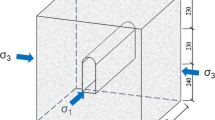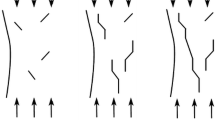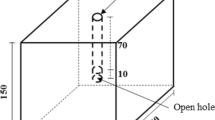Abstract
Splitting failure, which is recognized as a special engineering geology phenomenon, occurs continually in the brittle rock mass of caverns during underground excavation. In this paper, a splitting model of linear slippage crack groups is built with fracture mechanics, energy analysis, and crack extension theories. Considering intrinsic cracks in rock mass and change of outer stress, intrinsic cracks propagate into macroscopical splitting cracks that are approximately parallel to the side wall of caverns. The splitting criterion of cavern rock mass and the method for predicting displacement in view of splitting opening displacement are proposed. In the end, the forecasting method is applied to the Jinping-I Hydropower Station, underground caverns engineering in China, the splitting failure zone and forecasting displacement are accordant with the monitoring data. The new forecasting displacement method is proven to contribute to the construction of similar underground caverns.
















Similar content being viewed by others
Abbreviations
- \(c\) :
-
Half of the initial crack length
- \(l_{0}\) :
-
Half of the wing crack length
- \(w\) :
-
Half of the neighboring crack space
- \(\varepsilon_{\text{l}}\) :
-
Lateral deformation of brittle rock mass
- \(\varepsilon_{\text{le}}\) :
-
Lateral deformation (external far-field force)
- \(\varepsilon_{\text{lc}}\) :
-
Lateral opening deformation (microcrack propagation)
- \(U\) :
-
Complementary energy of system
- \(P\) :
-
Generalized force
- \(\Delta\) :
-
Generalized displacement
- \(\Delta U_{\text{e}}\) :
-
Strain energy of element
- \(\sigma_{i}\) :
-
Horizontal stress of element
- \(\Delta V_{i}\) :
-
Element volume
- \(\sigma_{1}\) :
-
Maximum compressive stress
- \(\sigma_{2}\) :
-
Intermediate compressive stress
- \(\sigma_{3}\) :
-
Lateral compressive stress
- \(\sigma_{n}\) :
-
Normal stress
- \(\phi\) :
-
Internal friction angle
- \(\tau^{*}\) :
-
Effective shear stress
- \(K_{\text{I}}\) :
-
Stress intensity factor
- \(K_{\text{IC}}\) :
-
Fracture toughness
- Γ:
-
Density function of splitting opening deformation
- \(E_{0}\) :
-
Modulus of deformation in undisturbed surrounding rock
- \(K_{I}\) :
-
Modulus of deformation in excavated surrounding rock
- \(\theta\) :
-
Angle between initial crack surface and horizontal direction
- \(\upsilon\) :
-
Poisson’s ratio
- \(\chi\) :
-
Initial crack density
References
Barla G, Fava AR, Peri G (2008) Design and construction of the Venaus powerhouse cavern in calcschists. Geomech Tunn 1:399–406
Bauch E, Lempp C (2004) Rock splitting in the surrounds of underground openings: an experimental approach using triaxial extension tests. In: Engineering geology for infrastructure planning in Europe, vol 104, pp 244–254
Chen SC, Dong YJ, Lu XM et al (2009) Special report on the safety monitoring for the water supply and power generation system and the underground powerhouse of Jinping-I hydropower project. Res. Jinping I Safety Monitoring and Management Center of Jinping Construction Bureau, pp 135–160 (in Chinese)
Dasgupta B, Dham R, Lorig LJ (1995) Three dimensional discontinuum analysis of the underground powerhouse for Sardar Sarovar Project, India. In: Proceedings of the 8th international congress on rock mechanics, pp 551–554
Dhawan KR, Singh DN, Gupta ID (2004) Three-dimensional finite element analysis of underground caverns. Int J Geomech 4:224–228
Dyskin AV, Germanovich LN (1993) Model of rockburst caused by cracks growing near free surface. In: Young P (ed) Rockbursts and seismicity in mines 93. Balkema, Rotterdam, pp 169–175
Exadaktylos GE, Tsouterlis CE (1995) Pillar failure by axial splitting in brittle rocks. Int J Rock Mech Min Sci 32(6):551–562
Fan SC, Jiao YY, Zhao J (2004) On modelling of incident boundary for wave propagation in jointed rock masses using discrete element method. Int J Comput Geotech 31(1):57–66
Hibino S, Motojma M (1995) Characteristic behaviour of rock mass during excavation of large caverns. In: Proceedings of 8th international congress on rock mechanics. Tokyo, pp 583–586
Itasca Consulting Group (2009) Flac 3D: fast lagrangian analysis of continuain 3Dimensions. Itasca Consulting Group, Minneapolis. http://www.itascacg.com/flac3d/index.php
Jiang YJ, Li B, Yamashitad YJ (2009) Simulation of cracking near a large underground cavern in a discontinuous rock mass using the expanded distinct element method. Int J Rock Mech Min Sci 46:97–106
Kemeny JM (1991) A model for nonlinear rock deformation under compression due to subcritical crack growth. Int J Rock Mech Min Sci 28:459–467
Lajtai EZ, Carter BJ, Duncan S (1991) Mapping the state of fracture around cavities. Eng Geol 31:277–289
Li XJ (2007) The study on experiment and theory of splitting failure in great depth openings. Dissertation, Shandong University
Li S, Lajtai EZ (1998) Modelling the stress–strain diagram for brittle rock loaded in compression. J Mech Mater 30:243–251
Li N, Sun HC, Yao XC et al (2008a) Cause analysis of circumferential splits in surrounding rock of bus-bar tunnels in underground powerhouses and reinforced measures. Chin J Rock Mech Eng 27(3):439–446 (in Chinese)
Li XJ, Zhu WS, Yang WM (2008) A splitting failure criterion of surrounding rock mass in depth and high in situ stress region and its engineering application. In: Proceedings of the international young scholars’ symposium on rock mechanics, pp 1125–1129
Li XJ, Zhu WS, Yang WM (2009) A new forecast method of opening displacement and its engineering application. In: 43rd US rock mechanics symposium, pp 167–171
Maghousa S, Bernauda D, Fréardb J, Garnierb D (2008) Elastoplastic behavior of jointed rock masses as homogenized media and finite element analysis. Int J Rock Mech Min Sci 45:1273–1286
Martin CD, Chandler N (1994) The progressive fracture of Lac du Bonnet granite. Int J Rock Mech Min Sci 31(6):643–659
Miao XX, An LQ (1999) Model of rock burst for extension of slip fracture in palisades. J Chin Univ Min Tech 28(2):113–117
Su GS, Feng XT, Jiang Q et al (2007) Intelligent method of combinatorial optimization of excavation sequence and support parameters for large underground caverns under condition of high geostress. Chin J Rock Mech Eng 26(Supp. 1):2800–2808 (in Chinese)
Wang T, Chen XL, Yang J (2005) Study on stability of underground cavern based on 3DGIS and 3DEC. Chin J Rock Mech Eng 24:3476–3481 (in Chinese)
Wang MY, Song H, Zheng DL, Chen SL (2006) On mechanism of zonal disintegration within rock mass around deep tunnel and definition of “deep rock engineering”. Chin J Rock Mech Eng 25(9):1771–1776 (in Chinese)
Wu AQ, Ding XL, Chen SH, Shi GH (2006) Researches on deformation and failure characteristics of an underground powerhouse with complicated geological conditions by DDA method. Chin J Rock Mech Eng 25:1–8 (in Chinese)
Yoshida H, Horii H (2004) Micromechanics-based continuum model for a jointed rock mass and excavation analyses of a large-scale cavern. Int J Rock Mech Min Sci 41:1119–1145
Zheng YR, Shen ZJ, Gong XN (2002) The principles of geotechnical plastic mechanics. China Architecture and Building Press, Beijing
Zheng WH, Zhu WS, Liu DJ (2012) Simulation of opening displacement of brittle rockmass at point of energy dissipation. Chin J Rock Soil Mech 33(11):3503–3508 (in Chinese)
Zhu WS, Li XJ, Zhang QB, Zheng WH et al (2010) A study on sidewall displacement prediction and stability evaluations for large underground power station caverns. Int J Rock Mech Min Sci 47:1055–1062
Zhu WS, Yang WM, Xiang L (2011) Laboratory and field study of splitting fracture on side wall of large-scale cavern and feedback analysis. Chin J Rock Mech Eng 30(7):1310–1317 (in Chinese)
Acknowledgments
The authors express sincere appreciation to anonymous reviewers for their valuable comments on improving this study. The study is jointly supported by grants from the National Natural Science Foundation of China (Grant No. 41372294, 41002098 and 41102184), Program for Changjiang Scholars and Innovative Research Team in University of China (No. IRT13075), Shandong Province Transportation Science and Technology Project (Grant No. 2008Y002) and China Scholarship Council.
Author information
Authors and Affiliations
Corresponding author
Rights and permissions
About this article
Cite this article
Li, X.J., Yang, W.M., Wang, L.G. et al. Displacement Forecasting Method in Brittle Crack Surrounding Rock Under Excavation Unloading Incorporating Opening Deformation. Rock Mech Rock Eng 47, 2211–2223 (2014). https://doi.org/10.1007/s00603-014-0599-4
Received:
Accepted:
Published:
Issue Date:
DOI: https://doi.org/10.1007/s00603-014-0599-4




